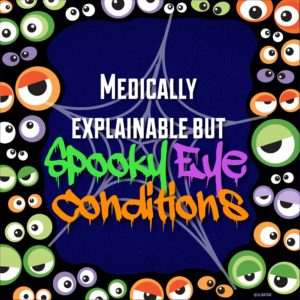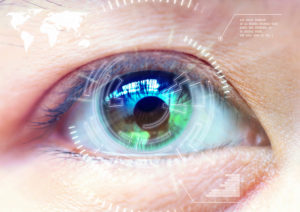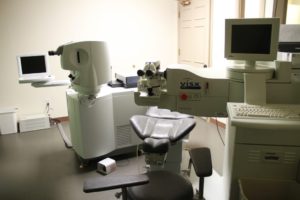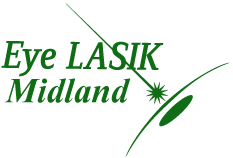
by EyeLASIK | Oct 18, 2016 | Eye Facts, Seasonal Tips & Tricks

Just because it’s strange doesn’t mean it’s unexplainable.
Boo! Are you ready for Halloween? All of us at EyeLASIK are certainly looking forward to it. The eyes are some of the most interesting parts of the human body. However, there are some spooky eye conditions that can occur. We’re here to share some information about unusual eye conditions that can be considered eerie, but are medically explainable!
Star-Shaped Cataract
From a medical standpoint, cataracts are often considered to be fairly common (https://en.wikipedia.org/wiki/Cataract). Generally, they occur in older patients or those with a history of smoking, diabetes, or genetic predisposition. The lens begins to cloud, causing vision difficulty. If they aren’t treated, the patient will eventually become blind.
However, one type of cataract is quite stunning in appearance. Several patients who have been involved in traumatic incidents have been diagnosed with star-shaped cataracts. You can see a video with the patient, who complained of gradual vision loss after being punched, here.
Heterochromia
While we’ve touched on this condition before, it’s important to note that this condition can affect both animals and humans. In this condition, the irises are two different colors. There are two types of heterochromia:
- Complete – Each iris is two separate colors.
- Sectoral – A portion of the iris is a separate color than the remainder.
- Central – Spikes of color different from the rest of the iris radiate from the pupil.

Having multiple eye colors isn’t creepy at all!
Haemolacria
This condition is by far the most unusual and is probably the most disturbing. This medical condition essentially causes a person to cry blood. Though there are only a handful of documented cases, they results are just as nerve-wracking. Some of the patients have experienced red-tinged tears, whereas others produce actual blood.
Some of the cases are attributed to unusual hormone production or tumors, while others were caused by eye injuries. However, the creepiest part is that, for some of the cases, there has been no medically explainable reason why the patients are producing bloody tears.
We hope we haven’t spooked you with these spooky eye conditions. Happy October!

by EyeLASIK | Oct 11, 2016 | eye health
While we realize that we’re in the laser eye surgery business, there are some horrifying facts about contacts that might make you rethink wearing them. We aren’t trying to scare you off of contacts, but you need to know…so you can beware.
Icky Infections From Ineffective Care
Contacts are high maintenance. It’s an unfortunate part of the bargain when you have to wear them. Did you know that it’s important to change out your contact solution daily, regardless of whether or not you’ve worn your contacts? It’s also just as important to clean the case where you store your lenses. Allowing your lens case to dry between usages can also prevent infections.
You Don’t Know What’s In The Water

Use contact lenses…if you dare.
Ever hear of the flesh-eating amoebas? They live in the water and you can’t even see them…
If you choose to go swimming, be sure to take out your contacts. Bacteria, including protozoans, live in bodies of water and can become trapped under your contacts. They’re even found in swimming pools and hot tubs.
Another way water is horrible for your contacts is by exposing them to tap water. Contact solution is sterile and it keeps your contacts from producing more bacteria. Water, especially tap water, is not.
If you want to gross yourself out, just Google Acanthamoeba keratitis. However, you should consider yourself warned. It’s really disgusting. If that won’t convince you to take out your contacts before exposing them to water, nothing will.
Creepy Costume Contacts
Contact lenses are considered medical devices and are regulated by the FDA. However, many costume contact lenses are popping up for sale without requiring a prescription. We suggestion you run far, far away from these. Non-regulated lenses can cause cuts and abrasions to your eye. They can also cause very bad infections, some serious enough to cause blindness.
If these stories have spooked you away from contacts, we recommend that you set up a complimentary consultation with EyeLASIK. We make the process painless and informative…there’s no reason to fear.

by EyeLASIK | Sep 27, 2016 | Seasonal Tips & Tricks
 Are puffy, itchy, red, watery eyes getting you down? Many people can relate. While most allergy sufferers think spring is the worst season for symptoms, autumn is a close second. However, we’re here to help you manage fall allergies to get your life back under control.
Are puffy, itchy, red, watery eyes getting you down? Many people can relate. While most allergy sufferers think spring is the worst season for symptoms, autumn is a close second. However, we’re here to help you manage fall allergies to get your life back under control.
Know What You’re Dealing With
In order to successfully treat your allergies, it’s important to know what you’re up against. Though the most common spring allergen is pollen, fall brings additional allergens to the mix. Dust, ragweed, and mold are usually brought in with cooler fall weather.
Keep It Clean
While the thought of cleaning your house more frequently is frustrating, it’s critical to keep surfaces swept, mopped, or vacuumed as often as possible. Be sure have your air filters changed regularly, especially when alternating between the heat and air conditioning.
In order to control mold and mildew spores, invest in a dehumidifier. Keeping your environment between 35% and 50% humidity. This “sweet spot” can alleviate dryness in your home without making it a welcome environment to spores.
Animal dander is also a common allergen. If you have indoor pets, it’s important to keep them professionally groomed to reduce shedding. Secondly, frequent baths and at-home grooming, like brushing, help to reduce dander particles.
Properly Medicate
Allergies can cause plenty of issues: severe eye irritation, wheezing, nagging coughs, and constant sneezing. However, there are various medications available to treat allergies, including many over-the-counter options. We recommend that you talk to your primary care physician, allergy spet, or optometrist for symptom-specific recommendations.
However, we have a few options for eye-related allergy sufferers:
- Use synthetic tears and rewetting drops can be to replenish moisture and flush out allergens.
- Antihistamines block the body’s nature response to allergens, the most common of which is itching.
- Decongestant drops can help shrink the blood vessels in your eyes, which reduce redness and irritation
We hope these tips have helped you figure out some techniques to manage fall allergies. While they can be bothersome, these are definitely practical steps you can follow to prevent them from taking over your life.

by EyeLASIK | Sep 13, 2016 | Eye LASIK

See clearer than clear.
“Ugh. It’s time to buy contacts or glasses again!” Is this something you’ve ever thought to yourself? Chances are you’ve already considered LASIK surgery to change your vision. So, what’s stopping you? Most people have three main reasons: it will hurt, there will be post-op complications, and it’s expensive. We want you to improve life with LASIK, so we’re here to dispel those rumors.
Rumor #1 – It Will Be Painful
You can expect some discomfort with any surgical procedure. However, many patients describe the feeling similarly to having something in your eye(s). Post-procedure, EyeLASIK provides you with aftercare instructions and medications. We prescribe specialty drops to help relieve the discomfort and irritation. The drops include a steroid and antibiotic to prevent infection and swelling.
After LASIK, you no longer have to worry about the discomfort of eyeglasses and contacts. Actually, many patients experience better sight after LASIK than they did with their corrective eyewear…and less irritation, too. That’s definitely a life changing experience.
Rumor #2 – There Will Be Complications
As with any medical procedure, there is some risk associated with undergoing LASIK. These risks include double vision, glares, vision changes, and under/overcorrections.
However, the facility at EyeLASIK chooses to utilize the most advanced technology available. Additionally, our surgical clinic is inside a sterile, highly reputable facility in order to minimize the chance of those complications. At Eye LASIK Midland we pride ourselves on offering the most advanced systems proven to give the best results. EyeLASIK has an extensive network of optometrists who trust our surgeons, staff, equipment, and facilities.
Rumor #3 – It’s Too Expensive
“How can I afford LASIK?” It’s a question we hear frequently. We completely understand where you’re coming from when you ask us.
It can feel like there a considerable upfront expense for LASIK. However, if you’re willing to take the time, add up how much money you spend each year on eye health. Contacts, frames, lenses, solution, cleaning kits, drops, and more…it all adds how. LASIK can pay for itself just by not having to buy contact lenses or glasses anymore. Think about it. If you’re like most people, you’re probably spending around $3000 on average. If that’s the case, LASIK will pay for itself in just a few years!
LASIK is also an approved medical procedure for FSA and HSA insurance plans. Check with your provider to find out more. EyeLASIK also offers flexible, interest-free financing options. Our team believes that if you change your vision, you can change your life. We want to help you experience that life change! We always offer complimentary consultations. We’re here to help you improve your life with LASIK and answer all of your questions.

by EyeLASIK | Aug 30, 2016 | Eye LASIK

Ask about the different types of LASIK surgery in your consultation.
LASIK is one of the best decisions you can make to improve your vision. However, if you’ve ever researched the decision, you’ve probably come across the several different types. It’s important to know the differences between them to help you choose the best option. We’re here to highlight the types of LASIK surgery.
PRK
While a PRK uses similar tools as LASIK, the surgeon foregoes creating a flap. The entire outer layer of the cornea is completely removed. An excimer laser reshapes the corneal tissue, and a new outer layer grows back within five days after the procedure.
LASIK (With An “I”)
LASIK is the most common form of laser eye surgery. A surgical laser creates a small “flap” on the surface of the eye. The flap is folded back in order to reshape the corneal tissue. After the cornea is adjusted, the flap is replaced in its original position, where it acts as a natural bandage that allows the eye to heal. Due to quick healing time, the flap reattaches itself securely, so there is no need for sutures.
LASEK (With An “E”)
The LASEK procedure is a combination of LASIK and PRK. Instead of completely removing the outer layer of the cornea like the PRK, the flap is pushed to the side so it remains attached to the eye on one side. This process exposes the corneal tissue for laser reshaping. After this step is completed, the outer layer is adjusted and a “bandage” contact lens is placed on the eye to keep the layer secured during the healing process.
Epi-LASIK
LASEK and Epi-LASIK are incredibly similar. However, the key difference is simply the type of tool used to loosen the outer layer of the cornea. This reduces the patient’s risk of a reaction caused by using alcohol, which is used in LASEK.
While this is a quick and simplified version of each of the types of LASIK surgeries, we recommend setting up a complimentary consultation for a more in-depth discussion. Each of these surgeries have high success rates and similar vision outcomes. It’s genuinely about what works best for you. During your consultation, our spets can help to determine which laser eye surgery is right for you.









